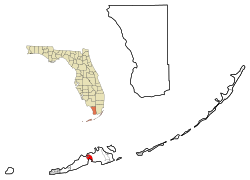Cudjoe Key
| Cudjoe Key, Florida | |
|---|---|
| Census-designated place (CDP) & Unincorporated community | |
 Location in Monroe County and the state of Florida |
|
 U.S. Census Bureau map showing CDP boundaries |
|
| Coordinates: 24°39′51″N 81°28′56″W / 24.66417°N 81.48222°WCoordinates: 24°39′51″N 81°28′56″W / 24.66417°N 81.48222°W | |
| Country |
|
| State |
|
| County | Monroe |
| Area | |
| • Total | 5.6 sq mi (14.6 km2) |
| • Land | 5.2 sq mi (13.6 km2) |
| • Water | 0.4 sq mi (1 km2) |
| Elevation | 0 ft (0 m) |
| Population (2000) | |
| • Total | 1,695 |
| • Density | 302.7/sq mi (116.1/km2) |
| Time zone | Eastern (EST) (UTC-5) |
| • Summer (DST) | EDT (UTC-4) |
| ZIP code | 33042 |
| Area code(s) | 305 |
| FIPS code | 12-15862 |
| GNIS feature ID | 1867131 |
Cudjoe Key is a census-designated place and unincorporated community in Monroe County, Florida, United States on an island of the same name in the lower Florida Keys. As of the 2000 census, the CDP had a total population of 1,695.
It was originally called Littleton Island.
The United States Army activated Cudjoe Key Air Force Station in 1959 to track missiles traveling through the Eglin Gulf Test Range. The Air Force took over operations the following year, and it subsequently became a detached installation of Homestead Joint Air Reserve Base. The station flies a white radar aerostat, known locally as "Fat Albert", which is used for drug interdiction missions by the Drug Enforcement Administration. On April 20, 2007 a Cessna 182 crashed after its left wing struck the tether anchoring "Fat Albert" [1][2]. The aerostat is marked on air navigation charts inside a restricted area that contains the warning, "Caution: Unmarked balloon on cable to 14,000 [feet]."
Cudjoe Key may be named after the Joewood tree (Jacquinia keyensis), a native species which is also known as cudjoewood, though a more likely derivation for the name is offered by writer John Viele of Summerland Key. He believes that Cudjoe, a very common Akan name, was the name of a fugitive slave or free negro who lived on the island at some point prior to Gerdes' survey in 1849.
...
Wikipedia
